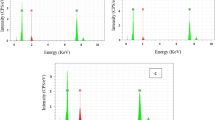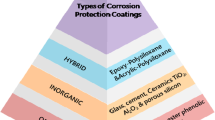Abstract
The corrosion protection of aluminum flake pigments has been extended by means of an encapsulating inorganic/organic silica/polystyrene hybrid nanolayer. A silica nanolayer encapsulated the surface of aluminum flakes (Al) by hydrolysis and polycondensation of tetraethylorthosilicate via sol–gel process to yield Al/Si flakes. Then, 3-methacryloxypropyltrimethoxysilane (MPS) was used as surface modifier which has polymerizable groups to participate in polymerization reaction (Al/Si/MPS). A polystyrene (PS) coating layer was applied on Al/Si/MPS flakes by free radical polymerization of styrene initiating with Azobisisobutyronitrile at 60 °C and subsequent washing of free chains with solvent yielded Al/Si/PS flakes. Fourier transform infrared spectroscopy, energy-dispersive X-ray spectroscopy and scanning electron microscopy showed that silica and PS nanolayers were formed on the aluminum flakes. The attached PS chains on the surface were detached by hydrofluoric acid aqueous solution and analyzed by gel permeation chromatography (GPC). Also, a transmission electron microscopy image showed clearly that the encapsulating layers are in the scale of nano. Good results were obtained in terms of corrosion protection in acidic and alkaline solutions, indicating that the silica/polymer hybrid nanolayer coating acts as an efficient protective film. After encapsulating the flakes, the evolved hydrogen volume was dropped and hybrid nanolayer resulted in no evolved hydrogen volume.







Similar content being viewed by others
References
Pi PH, Chen J, Chen K, Cai ZQ, Zheng DF, Wen XF, Cheng J, Yang ZR (2012) Effects of acid treatment on adhesive performance of encapsulated aluminium pigments on plastic sheets. Can J Chem Eng 90:1224–1230
Müller B, Franze K, Mebarek D (1995) Corrosion inhibition of aluminum pigments in aqueous alkaline media at different pH values. Corrosion 51:625–630
Jadhav N, Vetter CA, Gelling VJ (2013) The effect of polymer morphology on the performance of a corrosion inhibiting polypyrrole/aluminum flake composite pigment. Electrochim Acta 102:28–43
Liu H, Ye H, Zhang Y, Tang X (2008) Preparation and characterization of poly(trimethylolpropane triacrylate)/flaky aluminum composite particle by in situ polymerization. Dyes Pigment 79:236–241
Razavi-Tousi SS, Szpunar JA (2014) Mechanism of corrosion of activated aluminum particles by hot water. Electrochim Acta 127:95–105
Karlsson PM, Esbjörnsson NB, Holmberg K (2009) Admicellar polymerization of methyl methacrylate on aluminum pigments. J Colloid Interf Sci 337:364–368
Sabagh S, Bahramian AR, Kokabi M (2012) SiAlON nanoparticles effect on the corrosion and chemical resistance of epoxy coating. Iran Polym J 21:837–844
Ershad-Langroudi A, Rahimi A (2014) Effect of ceria and zirconia nanoparticles on corrosion protection and viscoelastic behavior of hybrid coatings. Iran Polym J 23:267–276
Sabagh S, Bahramian AR, Kokabi M (2012) SiAlON nanoparticles effect on the behaviour of epoxy coating. Iran Polym J 21:229–237
Karlsson P, Palmqvist AEC, Holmberg K (2006) Surface modification for aluminium pigment inhibition. Adv Colloid Interf Sci 128–130:121–134
Supplit R, Schubert U (2007) Corrosion protection of aluminum pigments by sol-gel coatings. Corros Sci 49:3325–3332
Popoola PAI, Omotayo S, Loto CA, Popoola OM (2013) Inhibitive action of ferrous gluconate on aluminum alloy in saline environment. Adv Mater Sci Eng 2013:639071
Yan M, Vetter CA, Gelling VJ (2010) Electrochemical investigations of polypyrrole aluminum flake coupling. Electrochim Acta 55:5576–5583
Guo L, Song W, Hu M, Xie C, Chen X (2008) Preparation and reactivity of aluminum nanopowders coated by hydroxyl-terminated polybutadiene (HTPB). Appl Surf Sci 254:2413–2417
Liang B, Wang GD, Zhang BY, Zhang XM (2014) Optimization of sol-gel coating on the surface of aluminum alloy powder for corrosion protection in the condition of ultrasonic radiation. Mater Corros. doi:10.1002/maco.201307270
Zhang Y, Ye H, Liu H, Han K (2011) Preparation and characterisation of aluminium pigments coated with silica for corrosion protection. Corros Sci 53:1694–1699
Li L, Pi P, Wen X, Cheng J, Yang Z (2008) Optimization of sol-gel coatings on the surface of aluminum pigments for corrosion protection. Corros Sci 50:795–803
Liu H, Ye H, Zhang Y (2008) Preparation and characterization of PMMA/flaky aluminum composite particle in the presence of MPS. Colloid Surf A Physicochem Eng Asp 315:1–6
Yan M, Vetter CA, Gelling VJ (2013) Corrosion inhibition performance of polypyrrole Al flake composite coatings for Al alloys. Corros Sci 70:37–45
Joubert M, Save M, Mornet S, Lavaud F, Pellerin V, Morvan F, Tranchant J-F, Duguet E, Billon L (2014) Surface patterning of micron-sized aluminum flakes by seeded dispersion polymerization: towards waterborne colored pigments by gold nanoparticles adsorption. Polymer 55:762–771
Liu H, Ye H, Zhang Y (2007) Preparation of PMMA grafted aluminum powder by surface-initiated in situ polymerization. Appl Surf Sci 253:7219–7224
Liu H, Ye H, Tang X (2007) Aluminum pigment encapsulated by in situ copolymerization of styrene and maleic acid. Appl Surf Sci 254:616–620
Li LJ, Pi PH, Wen XF (2008) Aluminum pigments encapsulated by inorganic-organic hybrid coatings and their stability in alkaline aqueous media. J Coat Technol Res 5:77–83
Sarsabili M, Parvini M, Salami-Kalajahi M, Asfadeh A (2013) Effect of MCM-41 nanoparticles on the kinetics of free radical and RAFT polymerization of styrene. Iran Polym J 22:155–163
Liu H, Ye H (2008) Synthesis and property of poly(trimethylolpropane triacrylate)/Al nanocomposite particle by in situ solution polymerization. Appl Surf Sci 254:4432–4438
Umoren SA, Obot IB, Ebenso EE, Okafor PC, Ogbobe O, Oguzie EE (2006) Gum arabic as a potential corrosion inhibitor for aluminium in alkaline medium and its adsorption characteristics. Anti-Corros Methods Mater 53:277–282
Diaconu G, Micusık M, Bonnefond A, Paulis M, Leiza JR (2009) Macroinitiator and macromonomer modified montmorillonite for the synthesis of acrylic/MMT nanocomposite latexes. Macromolecules 42:3316–3325
Supplit R, Schubert US (2007) Corrosion protection of aluminum pigments by sol-gel coatings. Corros Sci 49:3325–3332
Carre A (2007) Polar interactions at liquid/polymer interfaces. Adhes Sci Technol 21:961–981
Żenkiewicz M (2007) Methods for the calculation of surface free energy of solids. J Achieve Mater Manuf Eng 24:137–145
Subedi DP (2011) Contact angle measurement for the surface characterization of solids. Himalayan Phys 2:1–4
Acknowledgments
We are grateful for the financial support of the Iran National Science Foundation (INSF) (grant no. 91002479).
Author information
Authors and Affiliations
Corresponding author
Rights and permissions
About this article
Cite this article
Amirshaqaqi, N., Salami-Kalajahi, M. & Mahdavian, M. Corrosion behavior of aluminum/silica/polystyrene nanostructured hybrid flakes. Iran Polym J 23, 699–706 (2014). https://doi.org/10.1007/s13726-014-0264-5
Received:
Accepted:
Published:
Issue Date:
DOI: https://doi.org/10.1007/s13726-014-0264-5




